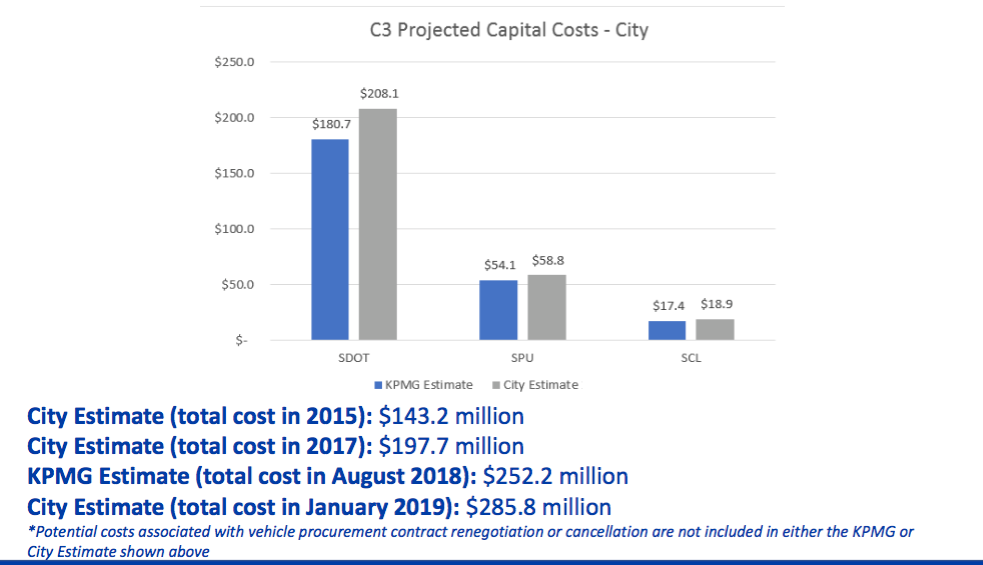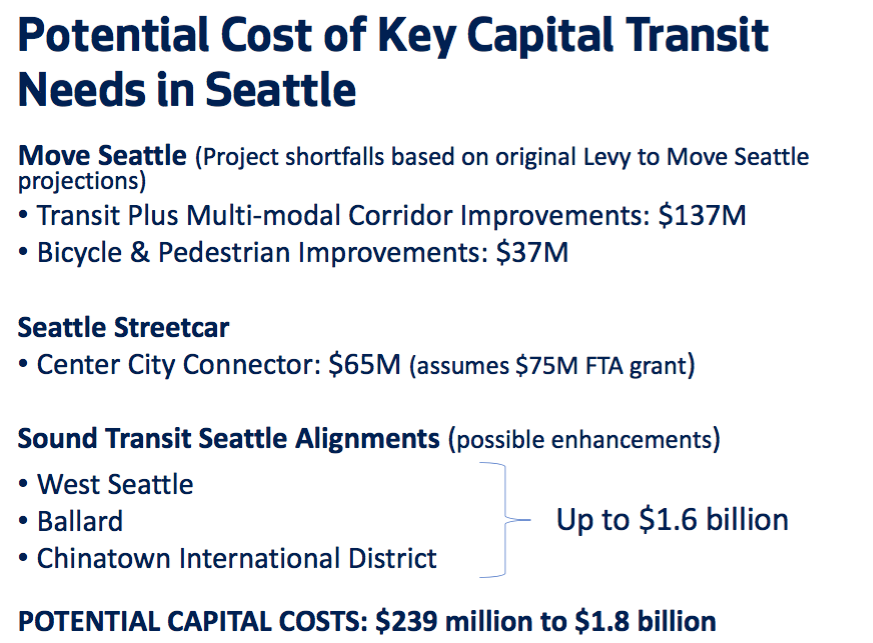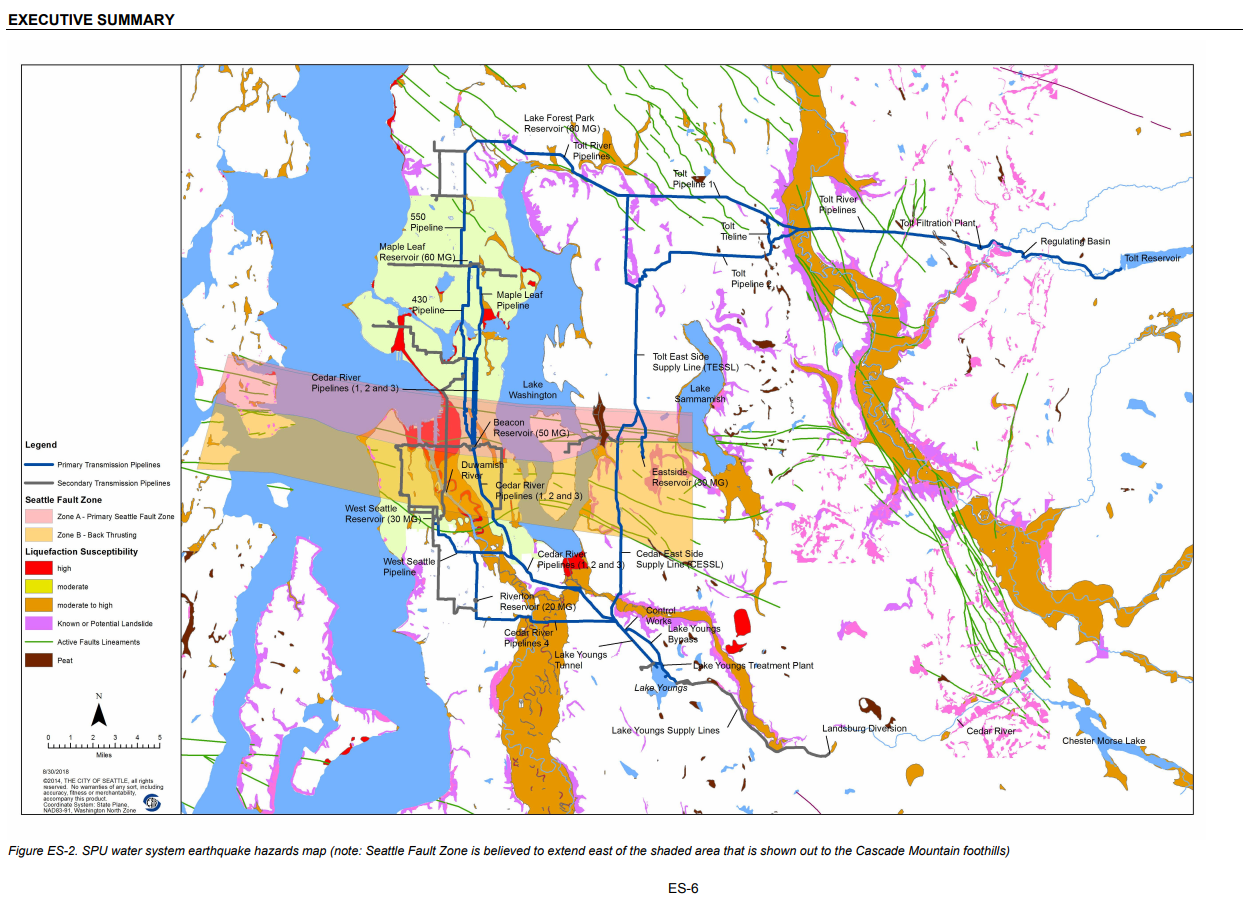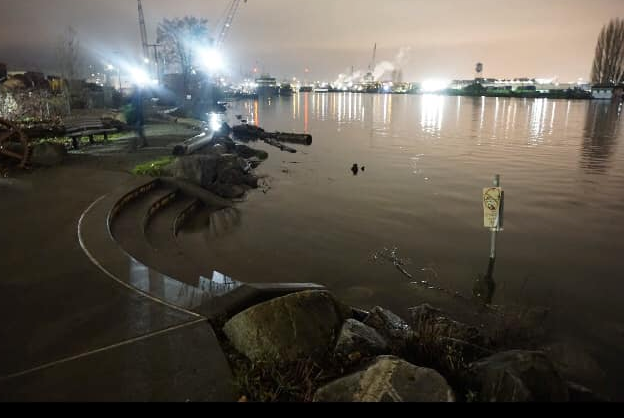Center City Streetcar Could Impact Other Needed Transit Investments, Such as a Sound Transit 3 Tunnel for West Seattle; Seattle Public Utilities Seismic Report; Language Preference Points Bring Help for SPD Recruitment; South Park King Tide Event; Neighborhood Street Fund Meetings & Online Voting
Center City Streetcar Could Impact Other Needed Transit Investments, Such as a Sound Transit 3 Tunnel for West Seattle
Last week Mayor Durkan announced updated construction and operations cost estimates for the proposed Center City Streetcar on 1st Avenue.
The construction cost estimate has increased to $286 million, and operations costs have increased to $28 million annually. Both represent significant increases over previous estimates, with large funding gaps. A potential opening would now be in 2025 rather than late 2018 as previously estimated in a 2015 grant application to the Federal Transit Administration.
I appreciate the Mayor’s commitment to providing realistic cost estimates; this stands in stark contrast to the previous administration and previous SDOT leadership. However, I remain very skeptical that building a center city streetcar would be the best use of very limited transportation funds. I have also long questioned whether the streetcar is truly a transportation project or whether it serves primarily economic development interests as Seattle Times columnist Danny Westneat did as well in his column last week.
The Council adopted a measure in the 2019 budget requiring Council approval of any construction spending.
Construction cost estimates
The updated construction cost estimate is $286 million; exactly double – a 100% increase from the 2015 estimate. The August independent report ordered by the Mayor estimated $252 million, up from $198 million in 2017. The latest increases are in part related to serious mistakes made with the streetcar vehicle design; here’s a link to a memo and report about that.
The funding gap construction is reported to be $65 million. However, this figure contains three assumptions: first, that the City will receive a $75 million FTA grant; secondly, it includes $45 million in bond funding which is a discretionary Council decision; and third, as noted in the presentation, there may be additional costs associated with extending or cancelling the current vehicle procurement contract.
While there would likely be costs to stopping the project, even with those costs, doing so would make significant additional funds available for other transportation purposes.
Operations cost estimates
The updated operations cost estimate is $28 million, a 75% increase from the $16 million in SDOT’s 2017 report required by the Council, per an amendment I sponsored. While the $16 million estimate is for 2020, and the $28 million is for 2025, it highlights the gap in the quality of information the Council received.
The annual estimated funding gap (i.e. city subsidy) appears to be $18 million for 2025.
The latest increases come in part from operating deficits of the current streetcars, which shows a $4 million annual operations funding gap, and which the Mayor included in the proposed 2019 budget. Sound Transit’s annual $5 million operations subsidy for the First Hill Line ends in 2023. Adding a center city streetcar would increase the gap from the current lines, and cost millions more each year.
Is a Center City Streetcar the best use of transportation funds?
There are other transportation priorities with either funding shortfalls, or unfunded needs. For example, multi-modal corridors and bike/pedestrian work have shortfalls compared to projections for move levy spending.
In addition, cost estimates for ST3 light rail for the West Seattle/Ballard line include tunnel options that could significantly increase the costs. It appears likely we will need to find additional funding, what Sound Transit refers to as “third party funding.” Costs could be higher in not just West Seattle, but also Ballard and Chinatown/ID. After the ST Board approves alternatives to study in a few months, we’ll have until 2022 to find additional funding.
The bottom line is that any funds we commit to a center city streetcar will not be available for better light rail options.
The original purpose behind the SLU and First Hill lines was to connect those neighborhoods to light rail; they serve that purpose. A Center City Streetcar, while it would connect the two other lines, would travel where light rail stations already exist, at Pioneer Square, University, and Westlake. In addition, the voter-approved ST3 line will add a second subway tunnel through Downtown and South Lake Union in 2035.
Buses productively serve the Downtown/SLU corridor; the C Line and the 40 are two of the busiest lines in the entire bus system. C Line ridership increased by more than 20% when the line was extended to South Lake Union.
I serve on the Regional Transit Committee. Last week we were briefed on the King County Metro 2018 system evaluation. The report shows, in District 1 alone, that the C Line, 120, 50, 37, 56, 21, 131, 132, 125, and 60 all needing additional service to meet KC Metro’s service guidelines for crowding, reliability, and service growth. The City uses the same criteria for funding the additional bus service approved by Seattle’s voters in 2014. Building a center city streetcar is unlikely to help us to meet those targets.
Seattle Public Utilities Seismic Report
Last week in my committee, Seattle Public Utilities (SPU) briefed us on the seismic report that they released late last year. Coverage by the Seattle Times reporter Daniel Beekman in December reported on the report vulnerability findings and recommendations. The last seismic report was commissioned by the utility in 1990. Since 1990 scientific knowledge and understanding about earthquakes has changed significantly. In 2016 SPU began conducting another study.
In the new report they considered Seattle Fault Zone and Cascadia Subduction Zone type earthquakes, up to magnitude 7.0 and 9.0 respectively. The goal of the study is to incorporate the current understanding of risks into long-term planning for capital improvements to SPU’s water distribution system.
Based on recommendations from the 1990 study SPU has invested $100 million over the last nearly 30 years on discrete seismic updates. However, the new report suggests spending an additional $40 – $50 million in short-term measures in the next 15 to 20 years; and $800 million over the next 50 years for long-term infrastructure improvements, totaling $850 million to improve seismic resiliency.
According to the report, there’s a 15 to 20 percent chance of a catastrophic earthquake – in the next 50 years – similar to the 2011 quakes in Christchurch, New Zealand (6.2 magnitude), and Tohoku, Japan (9.0 magnitude). In both of those instances it took over 45 days to restore water service to the affected areas. The report also stated that there’s an 85% chance of at least one earthquake – in the next 50 years – like the 2001 Nisqually quake that many of us remember.
Another big take-away is that, while previously SPU had begun decommissioning two reservoirs, the report indicated that the reservoirs are needed to provide emergency water. These are the Roosevelt and Volunteer reservoirs. However, even with these two reservoirs Seattle will still be below comparable cities for water access in an emergency. During the committee discussion I asked whether SPU should consider additional ways to increase our water capacity in the event of a catastrophic event so that it more closely aligns with other similar jurisdictions.
The cost, need, and type of upgrades will continue to be a focus of mine, especially when we update the Strategic Business Plan which sets a predictable rate path for six years, and is updated every three years – most recently in 2017. Affordability for ratepayers is top of mind for me even when confronting such necessary infrastructure upgrades.
Language Preference Points Bring Help for SPD Recruitment
Last week the Public Safety Civil Service Commission (PSCSC) adopted a rule Councilmember González and I sponsored to implement a language “preference points” program for the hiring of police officers. This allows people who fluently speak a language other than English to receive higher scoring in their examination. The rule incorporates suggestions from the Community Police Commission to help with the timetable.
Thanks to the PSCSC for taking this action, and to the Department of Human Resources (SDHR) to for their willingness to do the administrative work to target implementation in time for the summer testing period. Thank you as well to former Office of Police Accountability Auditor, Anne Levinson for making this recommendation in 2013.
Currently, veterans under state and federal are eligible for 10 preference points.
SPD is hiring all candidates who are eligible. Nevertheless, preference points serve two purposes that benefit recruitment and hiring goals. First, preference points show people with language skills—often immigrants and children of immigrants—that their skills are valued, and desired. 18% of Seattle residents were born outside of the United States, and 21% speak a language other than English at home. It’s important to appeal to all Seattle communities in seeking officers. Secondly, in demonstrating in a concrete way that we value these language skills, it may help actually expand the number of people who apply to become police officers.
I began work on this policy change during budget deliberations in 2016, to help recruitment and meet our hiring goals. The City has missed four recruitment classes since that time; adopting this earlier could have helped to expand the pool of potential applicants for uniformed officer positions. The change in administration has helped in getting this done, especially with cooperation from new leadership at SDHR.
This action helps implement a section of the May 2017 police accountability legislation adopted by the Council, which said,
“Consistent with Chapter 4.08, SPD shall use preference points in hiring sworn employees who are multi-lingual and/or have work experience or educational background providing important skills needed in modern policing, such as experience working with diverse communities, and social work, mental health or domestic violence counseling, or other similar work or community service backgrounds.”
This is similar to the preference points used by the King County Sheriff’s office since 2013.
The rule adopted by the PSCSC says, for the initial hiring of officers, says:
“The Director with the assistance of the Seattle Department of Human Resources shall, upon developing a verification process, implement a language preference points program, which is authorized by Ordinance 125315, for the certification of eligibility registers for initial hiring of Public Safety Civil Service positions in the Seattle Police Department.
Multilingual candidates who successfully complete the language verification process shall receive ten percent added to the passing mark, grade or rating only, based upon a possible rating of one hundred points as a perfect percentage. However, an applicant may only receive a total of 10 percent in preference points, regardless of what kind of preference points are applied.”
After the Council’s vote to approve a new contract with the Police Officer’s Guild, the starting salary for an officer is $81,000, increasing to $87,000 after 6 months, and $94,800 after 30 months.
Future work will focus on developing preference points’ criteria for the remaining community service elements.
South Park King Tide Event
Last week I attended a King Tide event in South Park led by Seattle Public Utilities (SPU). King Tides are the highest tides of the year, occurring naturally and predictably 2-4 times per year. By 2100, these types of events are expected to occur as frequently as monthly or daily due to climate change. South Park, along the Duwamish River, already experiences impacts during extreme weather events. South Park is among the most vulnerable areas in the city for sea level rise.
During King Tides, portions of the mostly industrial area in South Park experience street flooding when the SPU drainage system can’t work fast enough. SPU is building new drainage infrastructure in South Park. A stormwater collection and conveyance project, a pump station, and a water quality project are necessary and critical investments for South Park. Recent funding from the Flood Control Board (which I wrote about here) will support these efforts.
The tour included Duwamish Valley Action Plan & South Park Public Safety Plan project visits too.
Community partnerships are leveraging resources from SPU, Seattle Department of Transportation, Seattle Parks and Recreation Department, Seattle Police Department, Seattle City Light, Department of Neighborhoods, Office of Economic Development, Office of Arts and Culture, and Office of Sustainability and Environment in order to develop climate resilience, affordable housing, safety, and open space in South Park’s residential and industrial areas.
Neighborhood Street Fund Prioritization Meetings: February 2 and 4; Online Voting Open
The 2015 Move Seattle Levy included $24 million for the Neighborhood Street Fund. Projects are submitted by residents over three three-year cycles. We’re now in the second cycle, for 2019-2021.
The next phase is for community members to rank the projects proposed in each district and narrow down the number of projects; top-ranked projects will proceed to the voting phase in spring 2019.
You can click here to see a map of projects nominated during Phase 1; projects are arranged by Seattle’s 7 Council districts.
There’s two ways to vote.
First of all, you can attend a Community Prioritization Meeting. The meetings in District 1 will be at:
- Saturday, February 2: Youngstown Cultural Arts Center, 4408 Delridge Way SW, 10:30 a.m.-12:30 p.m.
- Monday, February 4: South Park Hall, 1253 South Cloverdale Street, 6:30 to 8 p.m.
Secondly, you can vote online. Here are all the project applications in District 1; you can link to information about each project. You can vote online here, selecting whether a project is high priority, lower priority, or in between.
You can sign up here to receive updates.
The meetings will begin with a presentation of each project proposed in the hosting district. The Department of Neighborhoods advises attendees to:
- Plan ahead: if you will be joining a community meeting, plan accordingly to arrive no later than the meeting start time.
- Do your research: in-depth project proposals will be available on our website January 28. Get to know the projects proposed in your district prior to attending a meeting or ranking online.
- Share: invite friends, family, and neighbors to participate, even if they reside in a different district.
Projects approved in the 2016-2018 phase include Chief Sealth High School Walkway Improvements, and Harbor Ave SW and SW Spokane St Intersection Improvements.
Posted: January 28th, 2019 under Councilmember Herbold, Education, Office of Police Accountability, Parks and Recreation, Police Department, Public Health, Seattle Public Utliities, Transportation
Tags: Center City Streetcar, Duwamish Valley Action Plan, King Tide Event, PSCSC, SDOT, Seismic Report, South Park, South Park Public Safety Plan, SPD, SPU





